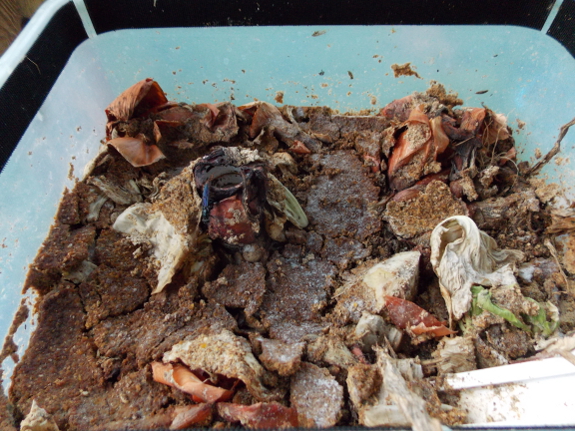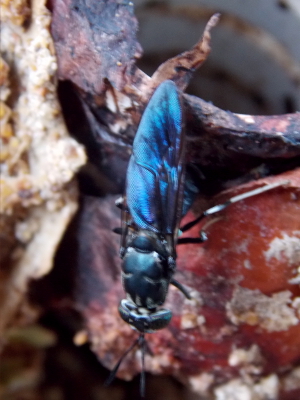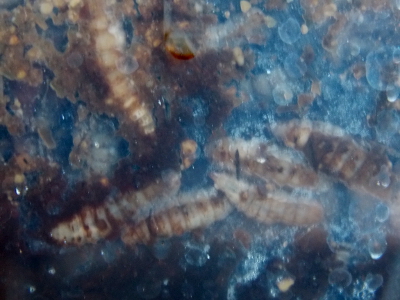
A thriving black-soldier-fly colony

 How do you know when your black-soldier-fly bin
is fully colonized? Keep stuffing kitchen scraps in, and pay
attention to how quickly the contents decline in size. At first,
it'll be a bit like a compost pile --- wilting and general decomposition
will reduce your scraps' volume down a bit, allowing you to add more a
week or so later. Then, suddenly, your fly larvae get on the job
and the voracious grubs eat the contents in mere days.
How do you know when your black-soldier-fly bin
is fully colonized? Keep stuffing kitchen scraps in, and pay
attention to how quickly the contents decline in size. At first,
it'll be a bit like a compost pile --- wilting and general decomposition
will reduce your scraps' volume down a bit, allowing you to add more a
week or so later. Then, suddenly, your fly larvae get on the job
and the voracious grubs eat the contents in mere days.
I'll be posting over on our chicken blog
next week about what we're feeding our black soldier flies, and about
our first trial of offering the pupae to our chickens. But I
thought you'd like to see a few photos of the bin in action in the
meantime.
There are now hundreds of grubs of various sizes visible through the walls of the bin, a clear sign that the few larvae I added out of the yard, plus the batch of eggs we purchased, aren't the only source of larvae.
Not that I'd need that information, since I caught a female black
soldier fly in the act of laying her eggs on an onion skin. No o ne
seems interested in laying in the cardboard strips on the top of the
bin, but the cycle of life is definitely working anyway. I've also
seen a lot of yellow soldier flies buzzing around, presumably adding their offspring to the festival.
ne
seems interested in laying in the cardboard strips on the top of the
bin, but the cycle of life is definitely working anyway. I've also
seen a lot of yellow soldier flies buzzing around, presumably adding their offspring to the festival.
I love it when
experiments like this just work, with nearly no effort on our
part. Woohoo for a thriving black-soldier-fly bin!
Want more in-depth information? Browse through our books.
Or explore more posts by date or by subject.
About us: Anna Hess and Mark Hamilton spent over a decade living self-sufficiently in the mountains of Virginia before moving north to start over from scratch in the foothills of Ohio. They've experimented with permaculture, no-till gardening, trailersteading, home-based microbusinesses and much more, writing about their adventures in both blogs and books.
Want to be notified when new comments are posted on this page? Click on the RSS button after you add a comment to subscribe to the comment feed, or simply check the box beside "email replies to me" while writing your comment.
